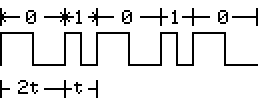
[ From monitor handling manual excerpt ]

Example) when of 1600bps
| 0 | File Attribute |
| 1 | File Name (9byte) |
| 2 | |
| 3 | |
| 4 | |
| 5 | |
| 6 | |
| 7 | |
| 8 | |
| 9 | |
| 10 | Loading first address (L) |
| 11 | Loading first address (H) |
| 12 | Data Size (L) |
| 13 | Data Size (H) |
| 14 | PROGRAM START Address (L) |
| 15 | PROGRAM START Address (H) |
| 16 | Extend Attribute |
| 17 | Blank Area (14byte) |
| 18 | |
| 19 | |
| 20 | |
| 21 | |
| 22 | |
| 23 | |
| 24 | |
| 25 | |
| 26 | |
| 27 | |
| 28 | |
| 29 | |
| 30 |
| 0 | 1 | |
| 0 | Data | Executable (Machine Language) |
| 1 | Loading Only | AUTO START |
| 2 | Continual data | Data File |
| 3 | CPU Memory | VDP Memory |
| 4 | Extended attribute it is | Extended attribute to be |
| 5 | Language Type (2) | |
| 6 | Language Type (2) | |
| 7 | Language Type (2) |
Language Type
| Free running | Tape Mark | FilecId... | IBG | Data Block | ... | IBG | Data Block | IBG | Data Block... | IBG | EOF |
FilecId ...
| Identification Flag | Byte number | File Attribute | File Name | Loading start address | ? | CheckSum |
Data Block ...
| Identification Flag | Byte number | DATA | CheckSum |
When the data of 1 byte is sent, adding the start bit and the stop bit, you send at 10 bits. (StartBit = 0, StopBit = 1)
EX) A5h... 0101001011 (StartBitc:lsb... MSB:StopBit)
Baud rate when saving is displayed with formula below.
((D1 + N) -1 + 2 (d0 + 2n) -1 ) / 3
When loading, the leader part (at the point where the mark is continual 256 or more because) with baud rate is calculated, it is not necessary for the user to appoint.
However, there is a limit in the following range of baud rate, theoretically the lower limit is 1170, upper limits approximately 4000. In addition, the lower limit as for 1170, upper limits 2830 was as the experimental value due to the general テレコ.